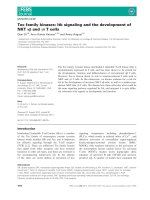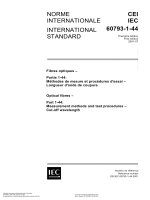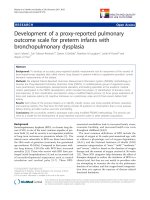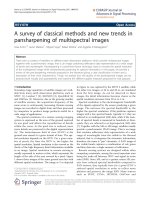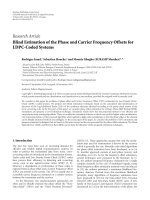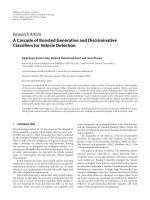Development of measurement methods and dose evaluating algorithms for electronic personal dosimeter
Bạn đang xem bản rút gọn của tài liệu. Xem và tải ngay bản đầy đủ của tài liệu tại đây (640.84 KB, 9 trang )
Nuclear Science and Technology, Vol.7, No. 3 (2017), pp. 25-33
Development of measurement methods and dose evaluating
algorithms for electronic personal dosimeter
Nguyen Duc Tuan, Mai Van Dien, Bui Duc Ky,
Chu Vu Long, Vu Van Tien, Nguyen Thi Thuy Mai
Institute for Nuclear Science and Technology,179 Hoang Quoc Viet, Ha Noi
Email: ,
(Received 01 Octorber 2017, accepted 28 December 2017)
Abstract: For personal radiation dose monitoring, electronic personal dosimeters (EPD), also known
as active personal dosimeter (APD), using silicon diode detector have the advantage capability of
measuring and displaying directly the exposure results of gamma, beta and neutron radiations in real
time. They are mainly considered as good complement to passive dosimeters to satisfy ALARA
principle in the radiation protection. In this paper, the meansurement methods and algorithms for
evaluating personal dose equivalents such as Hp(10) and Hp(0.07) from air-kerma are studied and
developed in two directions: the first, named energy correction method based on incident energy
determined by the ratio of two detector responses with the different filter configurations; the second
new method is carried out in the way that matching the shape of a detector’s energy response curve to
the kerma-to-personal dose equivalent conversion function provides an approximate means of
determining the dose equivalent without the need to resolve the actual incident energies. The
algorithm has also been experimentally verified at Secondary Standards Dosimetry Laboratory
(SSDL) of INST by the beam of radiation defined in ISO 4037-1. The obtained results of personal
dose equivalents with errors almost less than 30% in energy range from 20 keV to 1.5 MeV are
partially met the EPD design requirements according to the IEC 61526 Standard. The work and results
of described in this paper are important basics for design and construction of completed electronic
personal dosimeter.
Keywords: Personal dose equivalent, Silicon diode detector, EPD .
I. INTRODUCTION
Radiation monitors fall into the
categories
of
environmental
radiation
monitoring, personal dose monitoring, surface
contamination
monitoring,
radioactive
material monitoring and area process
monitoring. For personal dose monitoring,
electronic personal dosimeter carried in a
worker’s pocket measures and displays in real
time the amount of radiation received while
the worker performs their task. This dosimeter
is also equipped with a function that issues an
alarm in cases where the exposure dosage
exceeds a preset value. The development of
electronic personal dosimeters has made
progress in recent years, and an IEC standard
(IEC 61526) has been established for
electronic personal dosimeters.
The silicon PIN photodiode detector with
its advantage in sensitivity, volume, power
consumption, low cost, etc. is one of the key
components of the EPD for radiation detection
and measurement. However, because the
atomic coefficient of the detector is higher than
that of the tissue material and the sensitive
layer is thin, the photon energy response of the
Si-PIN detector is not consistent in the energy
range from 20 keV to 1.25 MeV, especially in
the low-energy region (less than 100 keV),
where the photon energy response is high. This
©2017 Vietnam Atomic Energy Society and Vietnam Atomic Energy Institute
DEVELOPMENT OF MEASUREMENT METHODS AND DOSE EVALUATING ALGORITHMS …
characteristic of detector seriously affects the
measurement accuracy of the instrument.
A. Energy correction method
The method of correcting the energy
response of the Si-PIN detector described here
solves the problem arising from over response
of the detector in the low energy range. To
determine exactly the personal dose equivalent
according to Eq.1, the related quantities such as
air kerma and dose conversion coefficient must
be determined. A simple algorithm for
determining personal dose equivalent is showed
in fig.2. In the standard laboratory, the air
kerma can be obtained by
The aim of the present study is to
develop the measurement methods and
algorithms to calculate the dose in terms of two
dose quantities Hp(10) and Hp(0.07)
(respectively, the personal dose equivalent at
10 and 0.07 mm depth) applicable for photon
energies in the range of 20–1250 keV to
archive an appropriate photon dosimetry
response used for electronic personal
dosimeter.
( )
II. METHODS AND ALGORITHMS
( )
( )
( )
(2)
( ).
(
)
( )
(3)
In the above equation, the detector’s
response function F(E) is used as an energy
correction factor of radiation field. Figure 3
shows the simulation result of relative energy
response function F(E) for a silicon PIN photo
diode using Al filter.
2
Cp(10), Cp(0.07) (Sv/Gy)
( )
)
where N is counts from detector,
CF(662) [Gy/Cnt] is calibration factor at 662
keV, F(E) is relative energy response function
of detector, which is normalised to photon
radiation of 137Cs at the calibration laboratory.
Hence, the equation (1) is transformed to
Secondary or operational quantities are
used for occupational monitoring. The ICRU39 (1985) has defined the operational quantities
for individual monitoring is personal dose
equivalent Hp(d). For photons, the reference
primary physical quantity is kerma, free in air,
or "air kerma”, Ka. Like the ambient dose
equivalent H*(d), the personal dose equivalent
Hp(d) is not directly measurable and therefore
also derived from air-kerma using appropriate
conversion coefficient. Energy dependent dose
conversion coefficients are used to establish the
relationship between the primary physical
quantities and the operational quantities Hp(d).
So that, for the case of mono-energetic photon
at energy E, the personal dose equivalent Hp(d)
can be determined by
( )
(
(1)
where Ka(E)[Gy] is air-kerma
and
Cp(E)[Sv/Gy] is air-kerma to dose equivalent
conversion coefficient.
The conversion
coefficients from air kerma Ka to the quantities
Hp(10) and Hp(0.07) for individual monitoring
for workplace monitoring depend on photon
energy as shown in Figure 1 (ICRP74 or
ICRU51).
1.5
1
0.5
Hp(10)/Ka
Hp(0.07)/Ka
0
6
600
E (keV)
Fig.1. Conversion coefficients from air kerma Ka to
Hp(10) and Hp(0.07)
26
NGUYEN DUC TUAN et al.
N1
Combined
Silicon
Diode
Detectors
E
R=N1/N2
N2
Cp(E
)
F(E)
Hp(d)
Ka(E)
CF(662)
Fig.2. Hp(d) Evaluating algorithm of energy correction method
counts from two detectors, information on the
photon energy can be derived. Assuming that
the counts collected by detector 1, 2 are N1, N2,
the ratio is described by
F(E) (Al 1mm)
100
10
( )
1
Equation (4) are established on the
premise that the detection system meets the
narrow-beam geometry. Under broad-beam
geometry conditions, the influence of the
scattered photons must be considered. By
Monte Carlo simulation, the calculations are
performed to demonstrate for determining ratio
of detectors using different filters including
1mm aluminium and 1.5 mm aluminium +
0.3mm tin. The obtained result illustrated in
fig.4 shows a relationship between R and the
beam energy.
0.1
10
100
(4)
1000
E (keV)
Fig. 3. Relative energy response function of
detector
However, it is necessary to know
information on photon energy in order to
consider the response characteristics and dose
conversion coefficient as a function of their
energy dependence. Additional, the methods
used to determine the energy of incident
photon based on spectral distribution are not of
practical application routinely. Thus, the
purpose of this work is to develop an
alternative method to estimate effective energy
of radiation beam, as Tandem method. The
basic principle of method is based on the
absorption effect in the different materials of
incident radiation. The narrow, monotonic
beam of radiation passing through the filter is
attenuated in the exponential law and depends
on the energy of radiation beam. So with the
different filter configurations, from the ratio of
R = (n Al/n Al+Sn)
80
8
0.8
10
100
E (KeV)
1000
Fig. 4. The relationship of ratio of counts and
photon beam energy
27
DEVELOPMENT OF MEASUREMENT METHODS AND DOSE EVALUATING ALGORITHMS …
matching the shape of a detector’s energy
response curve to the kerma-to-personal dose
equivalent conversion function provides an
approximate means of determining the dose
equivalent without the need to resolve the
actual incident energies. As long as R(E) has a
similar energy response to that of Cp(E), the
dosimeter measurement can be said to be
accurate. Based on this design philosophy, the
ratio determined by:
Based on calculation results, the ratio of
counts detected by two detector is a function of
energy and can be expressed by
( )
( )
( )
( )
(5)
For the case of incident radiation energy
greater than 200 keV, the ratio is
approximately 1 corresponding to energy of
662 keV. Therefore, the dose conversion
coefficient Cp(E) and energy response F(E)
can be determined through the energy value
given by Eq.5. Also, the value of Hp (d) can be
easily obtained.
( )
In actual field conditions, the energy of
the photons is not known. The aim of this
method described here is to discuss how the
difficulty encountered in the above method can
be overcome in a different approach. In the
effect of the radiation field, that is, to the count
readings N, of the detectors worn by the
exposed individual, and air kerma, Ka, have
the following relation analogous to following
equation
( )
(7)
is termed dose calibration constant k[Sv/Cnt],
which defines the traditional energy response
of the dosimeter in terms of dose equivalent
per unit count. This is a quantitative
formulation of a design criterion for detectors.
Assuming such a fitted dosimeter system, one
immediately obtains
B. Fitted-shape method
( )
( )
( )
( )
(8)
This is the relationship being sought
between H and N. It is significant for arbitrary
movements of the individual within radiation
fields with variable energy spectra. The
detector response function, R(E), can be
determined in monoenergetic, monodirectional
radiation fields. In order to measure Hp(d)
according to equation (8) the dose calibration
constant k must be determined from equation
(7). In order to satisfy equation (7), the
following “fitting procedure” is carried
through. The algorithm of these determination
and fitting procedure are implemented as
shown in fig. 5.
(6)
where R(E) is energy dependent detector
response function in units of counts per unit air
kerma. Equation (6) implies that N, is
proportional to air kerma in the case of
monodirectional
monoenergetic
radiation
fields. Most detectors for photons have this
property. Note the similarity in form between
Eqs. (1) and (6). Assuming that the photon
field are identical, it has been shown that
28
NGUYEN DUC TUAN et al.
Combined
Silicon
Diode
Detectors
NAl
N=a.NAl+b.NCu
NCu
Hp(d)=k.N
k= Cp(E)/R(E)
Fig.5. Hp(d) Evaluating Algorithm of Fitting-shape Method
25.00
(9)
RER ( to Cs 137)
5.00
and
R(E) =
1.00
0.20
Cu 0.4mm
( )
Al 1mm
0.01
Sn 0.7mm
100
E (keV)
(10)
(
( )
( )) (11)
for the desired energy range. The
constants a, b and k in equation (11) are
obtained by using the 3D least square fit
method of the curve fitting
z=ax+by where
( ). The
z= ( ), x= ( ) and y=
practical values and formulation of Hp(d) for
application will be calculated in detail in the
experimental part.
0.00
10
( )
From Eqs. (7) and (10), this method
involves solving the following equations
Fe 0.5mm
0.04
( )
1000
Fig.6. Filtered detector’s response
Based on the evaluation results of the
metal filtered silicon (PIN) diode detector
relative energy response (RER) as shown
in fig.6 by Monte Carlo radiation transport
methods and the known shape of the kerma
to personal dose equivalent conversion
function curve, this dose calculation
algorithm is implemented mathematically
by combining the signals of the two silicon
diode detectors with different filters, 1 mm
Al and 0.6 mm Cu, expressed by NAl and
NCu counters. The linear combination of
counts and the coresponding responses are
determined by:
III. EXPERIMENTAL RESULTS
In the experimental part, we considered
and carried out in detailed only the algorithm
of fitted-shape method by its advantages in
compared with the energy correction method
for evaluating the Hp(d) quantities. The
prototype EPD has been built and an
experimental setup is shown in Fig. 7 with the
hardware consists of the following parts.
Two filtered Si-PIN diode detectors
Pre-Amplifier
Pulse Shaper
29
DEVELOPMENT OF MEASUREMENT METHODS AND DOSE EVALUATING ALGORITHMS …
Pulse Discriminator
Counter 1, 2 and Microcontroller
RS-232 Interface and PC
signal by using a shaping amplifier, and then to
logic pulse for digital counting by
discriminator. Microcontroller counts the
pulses from two independent channels of SiPIN photodiode detectors to obtain the count
rate [cpm], which were transmitted to the PC
by serial communication RS-232 for
calculation.
The Si-PIN photodiode detector
generates the pulse charge output by the
incident photon. The charge is converted to
voltage by the charge pre-amplifier. The longwidth signal is converted to a practical pulse
Si Detector 1
Pre-Amplifier
Shaping
Discriminator
Al Filter
Si Detector 2
Microcontroller
Counter-1
Pre-Amplifier
Shaping
RS-232
INTERFACE
Discriminator
Cu Filter
Counter-2
PC
Detector
Bias Voltage
Low Voltage
Power Supply
Prototype EPD
Fig.7. Experimental Hardware Block Diagram
spectrum series used in the research described
in this paper mainly include N-30 (24 keV), N40 (33 keV), N-60 (48 keV), N-80 (65 keV),
and N-100 (83 keV) and a high-energy
reference radiation is based on 137Cs (662 keV)
and 60Co (1.25 MeV) isotope radiation sources.
Measurement results of the Al and Cu filtered
detector’s energy responses on air-kerma rate
are shown in table I and illustrated on Fig. 8.
From these data, the fitting procedures by least
square fit were carried out in case of Cp(10)
according to equation (11) and the linear
combination response R10(E) of two practical
responses were obtained for two energy ranges
based on ratios of RAl/RCu>1 (E<100 keV) and
To
investigate
the
dosimetry
characteristics of the method, experiments were
performed for an actual photon radiation field.
The prototype EPD was located in the front of
the ISO PMMA Phantom (30x30x15 cm3) and
the Si detectors was coincident with the center
of the reference radiation fields at the
Secondary Standard Dosimetry Laboratory
(SSDL) of Institute for Nuclear Science and
Technology (INST). The experimental data has
been obtained by performing irradiation
according to the following characteristics of
reference radiation field. A low-energy
reference radiation is based on the narrowspectrum series of the ISO Standard 4037-1
produced by an X-ray machine. The narrow-
RAl/RCu ≤1 (E≥100 keV) as follows.
30
NGUYEN DUC TUAN et al.
For E<100 keV:
show good matching or similarity of combined
response and conversion function (Fig.9). The
formulation of Hp(10) quantities are given in
Eqs. (14) and (15).
R10(E) = (0.0712 RAL(E)+0.0093 RCu(E)) (12)
For E≥100 keV:
R10(E) = (-14.2683 RAl(E)+14.5254 RCu(E))(13)
For E<100 keV:
Hp(10) = 0.102 (0.0712NAl+0.0093NCu) (14)
The calculated ratios shown in table II
with error less than 25% from average one
Table I.
1000
RAl
RCu
cpm/(µGy/h))
(cpm/(µGy/h))
0
33
48
65
83
662
1250
81.9
152.97
262.66
268.98
314.57
54.15
33.67
0.004
0.643
84.811
193.38
310.311
54.15
33.67
Ratio
RAl/ RCu
100
10
R(E)
E
(keV)
20475
237.9
3.1
1.39
1.01
1
1
Al 1mm
Cu 0.6 mm
1
0.1
0.01
0.001
10
100
E (keV)
1000
Fig. 8. Energy responses of Al and Cu filtered
silicon diode detectors
For E≥100 keV:
Hp(10) = 0.110(-14.2683NAl+14.5254 NCu) (15)
Table II.
E
(keV)
R10(E)
Ratio
k=Cp(10)/R10(E)
Error
(%)
20
33
48
65
83
661
1250
5.83
10.89
17.92
17.36
19.51
13.92
8.66
0.105
0.107
0.092
0.108
0.097
0.087
0.133
2.69
5.33
9.71
6.21
4.52
20.90
20.90
Average of Ratios
(E<100 keV)
Average of Ratios
(E>100 keV)
0.102
0.110
Fig. 9. Similarity of combined response
R10(E) and conversion function Cp(10)
The same procedures have also been done
for the case of Cp(0.07) to determine
combination response R0.07(E) in Eqs. (16), (17)
and the formulation of Hp(0.07) quantities are
given in Eqs. (18) and (19).
For E<100 keV:
31
DEVELOPMENT OF MEASUREMENT METHODS AND DOSE EVALUATING ALGORITHMS …
R0.07(E)=(0.08034 RAl(E)+0.02734 RCu(E))
(16)
Hp(0.07)=0.111(0.08034 NAl+0.02734 NCu)
For E≥100 keV:
(18)
For E≥100 keV:
R0.07(E)=(-13.9696 RAl(E)+14.1553 RCu(E))
For E<100 keV:
(17)
Hp(0.07)=0.142 (-13.9696 NAl+14.1553 NCu) (19)
Table III.
E
(keV)
R0.07(E)
Ratio
k=Cp(0.07)/R0.07(E)
Error
(%)
20
33
48
65
83
661
1250
6.58
12.27
18.78
16.32
16.79
10.06
6.25
0.159
0.106
0.085
0.105
0.101
0.119
0.165
42.68
4.84
23.48
5.33
9.03
15.98
15.98
Average of Ratios
(E<100 keV)
Average of Ratios
(E>100 keV)
0.111
0.142
Fig. 10. Similarity of combined response R0.07(E)
and conversion function Cp(0.07)
Table IV.
Energy
(keV)
20
33
48
65
83
662
1250
Kerma
(µGy)
Delivered
Hp(10)
(µSv)
Counts
NAl
Counts
NCu
Measured
Hp(10)
(µSv)
Error
(%)
Delivered
Hp(0.07)
(µSv)
Measured
Hp(0.07)
(µSv)
Error
(%)
483.18
295.22
43638
2
317.03
996.91
609.11
83790
2
608.75
7.4
504.92
390.25
22.7
0.1
1041.77
749.35
28.1
259.09
303.14
45880
127
534.28
625.11
83465
381
333.21
9.9
336.82
409.93
21.7
606.03
3.1
694.56
745.29
7.3
847.82
991.95
106485
647
773.02
22.1
1102.16
950.35
13.8
290.85
479.90
76777
25086
533.91
11.3
465.36
610.27
31.1
438.15
722.94
97673
33388
677.82
6.2
701.04
771.88
10.1
321.21
603.87
89257
44931
605.69
0.3
552.48
661.48
19.7
404.54
760.54
98412
49586
667.77
12.2
695.81
729.18
4.8
449.46
844.99
102782
51814
697.40
17.5
773.08
761.49
1.5
322.44
612.63
87395
74433
564.07
7.9
548.15
555.03
1.3
491.05
834.78
649.98
22.1
932.99
104081
92261
668.32
28.4
50.00
60.50
2830
2830
80.14
32.5
60.00
74.64
24.4
125.00
151.25
6956
6956
196.97
30.2
150.00
183.47
22.3
500.00
605.00
25334
25334
717.37
18.6
600.00
668.20
11.4
833.33
1008.33
37554
37554
1063.41
5.5
1000.00
990.52
0.9
1250.00
1512.50
54354
54354
1539.13
1.8
1500.00
1433.63
4.4
2.16
2.48
71
71
2.02
18.6
2.22
1.88
15.3
4.40
5.06
141
141
3.99
21.1
4.53
3.72
17.9
1.28
1.47
46
46
1.30
11.6
1.31
1.21
8.1
32
NGUYEN DUC TUAN et al.
angular response of the dosimeter. This,
however, is foreseen to be carried out in a
further step.
The work and results of described are
important basics for design and construction of
completed electronic personal dosimeter.
It is can be seen from the obtained Eqs.
(14), (15), (18) and (19) that the personal dose
equivalents Hp(d) have a simple one-to-one
relationship with the counting numbers of
pulses acquired from two detectors. To confirm
the validity of the algorithm, the accumulated
doses were evaluated from prototype EPD
exposed to the beams with delivered doses
from different air-kerma rate for 1 minute using
the formulas above and count readings for
calculating Hp(d). The obtained results of
personal dose equivalents are given in tables IV
with errors almost less than 30% between
delivered and measured ones in energy range
from 20 keV to 1.25 MeV. In this study, all the
fitted parameters and calibration constant k
were determined above in experimental time
for evaluating personal dose equivalents. In
general case of calculation of dose equivalents
based on Eq (8), beside of the energydependant counting number N which is not
changed as characteristic of detector’s silicon
material, however, the factor k as sensitivity of
EPD should be recalibrated periodically to
ensure the accuracy of the measurement.
REFERENCES
[1] Dang Thanh Luong, PhD thesis, “Some results
of research on methods of measurement of
ionizing
radiation
dose
by
the
thermoluminescent dosimeter”
[2] B R L Siebert, R Hollnagel and R Jahr
Physikalisch, “A theoretical concept for
measuring doses from
external radiation
sources in radiation protection”, Phys. Med.
Biol., 1983, Vol. 28, No. 5, 521-533.
[3] F. Sinclair, A. Clapp, G. Entine, R.M.D., 4 4
Hunt St., Watertown, MA 02172 and S.
Kronenberg ...”Energy Compensated Solid
State Gamma Dosimeter”.
[4] H. Stadtmann, C. Hranitzky, “Comparison of
different dose algorithms used to evaluate a
two element LiF:Mg,Ti TL personal
dosimeter”,
Radiation
MeasurementsH
HVolume 43 Issues 2-6H, , pp 571-575 (2008)
IV. CONCLUSIONS
[5] International Organization for Standardization.
X and Gamma Reference Radiation for
Calibrating Dosemeters and Doserate Meters
and for Determining their Response as a
Function of Photon Energy. ISO 4037-1
(Geneva: ISO) (1996).
In this paper, the measurement methods
and dose evaluating algorithms for electronic
personal dosimeter were described in detail.
The testing of the algorithm for prototype EPD
exposed by the beam of radiation defined in
ISO 4037-1 at SSDL of INST shows good
results
of personal dose equivalents are
partially met the EPD design requirements
according to the IEC 61526 Standard and
proving the suitability of the algorithm for
evaluating personal dose equivalents. This
paper does not include information from the
[6]
33
International Electrotechnical Commission.
Radiation
protection
instrumentation.
Measurement of personal dose equivalent
Hp(10) and Hp(0.07) for X, gamma, neutron
and beta radiation: direct reading personal dose
equivalent and monitors. IEC 61526 (Geneva:
IEC) (2005).


